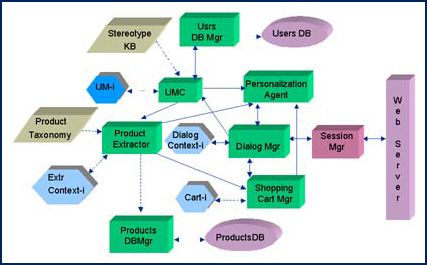Intelligent User Interfaces Home >>>research>>>SETA
SETAServizi Telematici Adattativi (SETA) was a three years project sponsored by Telecom Italia within the Cantieri Multimediali initiative, which involved three Italian Universities, each of them responsible for a different project, sharing the goal of promoting activities on multimedia services. The agreement between the University of Torino (Dipartimento di Informatica) and Telecom Italia for the project Servizi Telematici Adattativi lasted from May 1st, 1997 to April 30th, 2000.  The main goal of this project was the design and development of a prototype to support sales in Web stores, focusing on the personalization of the interaction with the system users, i.e. on tailoring the interaction with customers to their preferences and needs. This has recently become a hot topic of research, as a consequence of the quick and world-wide expansion of the Internet; in fact, lots of Web malls and shops exist and are accessed by users with different expertise and interests, who may need support to explore the catalogues and select the products for purchase. In order to approach the overall goal mentioned above, we have designed a system architecture which satisfies the following requirements:
 The SETA system is based on a multi-agent architecture, where specialized agents have been designed to carry on the activities of the front-end of a Web store. The distribution of tasks is essential to support a reactive adaptivity of the system during the interaction with the user. The multiagent system has been developed by exploiting the facilities offered by an agent building tool (Objectspace Voyager), which supports a seamless distribution of agents, a parallel execution of the agents code and a sophisticated communication among agents, where synchronous, asynchronous and multicast messages can be exchanged. By April 2000, the SETA system was fully implemented and it was instantiated in the telecommunication domain, as a prototype presenting products such as phones, answering machines, switchboards, and so forth. The prototype is accessible through the SETA Project Web site. For more information about this project, please contact
|





